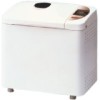Panasonic SDYD205 SDYD250 User Guide - Page 20
Other Ingredients Used For Flavored Loaves, Tips For Baking Whole Wheat & Multi Grain Breads
 |
View all Panasonic SDYD205 manuals
Add to My Manuals
Save this manual to your list of manuals |
Page 20 highlights
Other ingredients used for flavored loaves Egg: These are sometimes added to nutritionally enrich the dough, they also improve the keeping properties and colour of the baked product. Medium sized eggs are used. Fruits: Dried fruits are used in some of the following recipes. Total weight of dried fruits used should not exceed recommendations in the recipes. When using fresh fruit, use only as directed in the following recipes, as the water content of the fruit will affect the loaf volume. Bran: Approximately 4-5 tbsp can be added to boost the fibre content. (Do not use more than this recommended amount as it will affect the volume of the loaf). Bran cereals may be used in more quantities. Refer to recipes. Wheat germ: Approx 60 ml (4 tbsp) can be added to give a nuttier flavour. Herbs: Herbs are used to add flavour to the bread. These can be used fresh or dried. If using dried herbs only small amounts (1-2 tsp) are required. For fresh herbs follow the guidelines in the recipes. Vitamin C (Ascorbic Acid): Ascorbic acid is a bread improver i.e. it helps improve the volume of the loaf. This is now incorporated into the Fast Action Easy Bake yeast and does not have to be added as a separate ingredient, although we recommend adding 1/4 tsp Vitamin C powder to certain whole wheat loaves to improve the rise. Nuts: Nuts may be used, but chop them finely. Use no more than the recipe recommends. The height of bread when nuts are used, may be low because the chopped nuts will cut the gluten structure. When adding nuts as well as dried fruit, their total weight should not exceed that recommended in the recipes. Remember to chop them finely as these interfere with mixing. Spices: Spices are used to add flavour to the bread. Only small amounts (1 teaspoon to 2 teaspoon) are required. Seeds: These may be added to give flavour and texture to the bread. Be careful if using larger seeds, that are particularly hard, as they could scratch the non-stick coating. Tips for baking whole wheat and multigrain breads The result of breads, such as whole wheat breads and multigrain breads, are affected greatly by the quality of ingredients, especially the flour. The flour quality is affected by the keeping methods, the temperature, humidity, etc. Another important factor about the flour is that its quality also differs from year to year, season to season due to the quality of the wheat crop affected by the weather. Sometimes due to bad weather conditions, the crop may not grow with as much gluten forming properties as it would require to produce flour for making excellent breads. When the quality of flour is poor, the bread may not rise, or collapse after rising due to weak gluten. In such cases, take the following measures to obtain better results. 1. At least 1/8 of the flour (about 7 oz.) should be white bread flour, rather than whole wheat flour. and/or 2. Reduce 1/8 cup to 1/4 cup of water from the regular amount. If above still does/do not solve problems, 3. Reduce the amount of dry yeast to 1 teaspoon. The loaf produced by above methods may be low or small. 19















